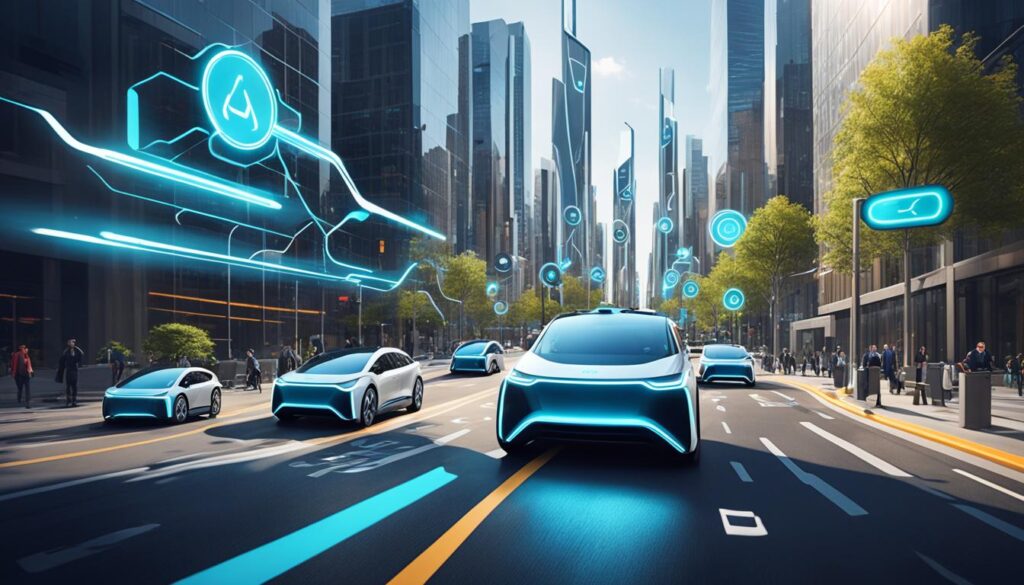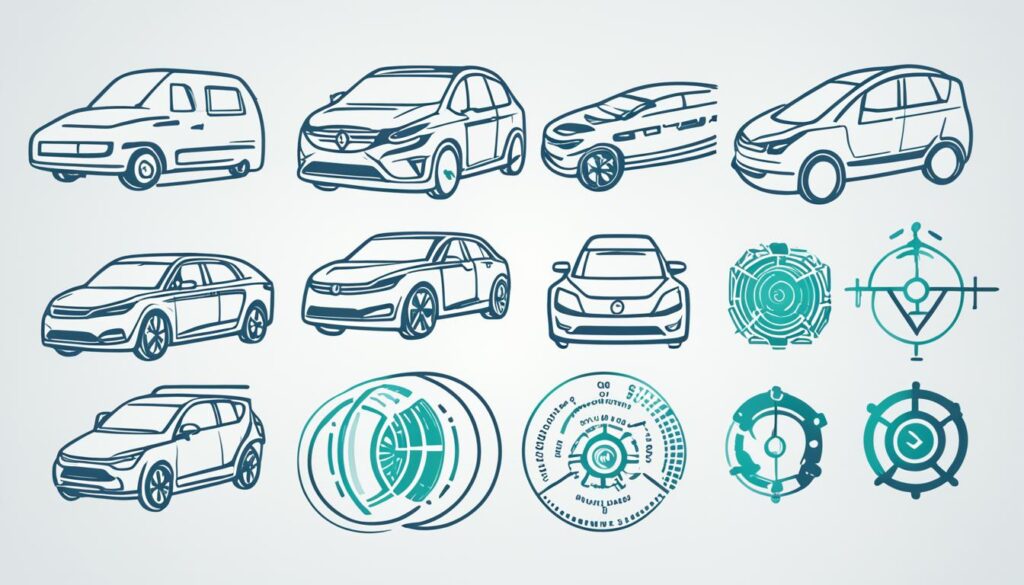Did you know that the global market for autonomous vehicles reached a staggering value of $76.13 billion in 2020? And it’s projected to skyrocket to $2,161.79 billion by 2030! This unexpected fact highlights the immense scale and impact of autonomous vehicles on the future of transportation.
Key Takeaways:
- The autonomous vehicles market is projected to reach $2,161.79 billion by 2030, showcasing its rapid growth and potential for innovation.
- Advancements in technology, including artificial intelligence and sensor technology, are driving the revolution in autonomous vehicles.
- The key trends in the autonomous vehicles market include increased investment in research and development, growing demand for connected and electric vehicles, and regulatory support.
- The technology landscape of autonomous vehicles is constantly evolving, with advancements in sensor technology and AI algorithms reshaping the industry.
- Autonomous vehicles are categorized into six levels of autonomy, ranging from limited self-driving capabilities to full automation.
The Growth of Autonomous Vehicles Market
The autonomous vehicles market is experiencing rapid growth driven by increasing investment in research and development efforts, advancements in technology, and the promise of improved safety, convenience, and efficiency in transportation. As governments, automakers, and technology companies embrace the potential of autonomous vehicles, the market is projected to reach $2,161.79 billion by 2030, exhibiting a compound annual growth rate (CAGR) of 40.1% from 2023 to 2030.
This exponential growth can be attributed to several key factors:
- Investment in Research and Development: Companies across the globe are ramping up their research and development efforts to develop cutting-edge autonomous technologies. This substantial investment enables continuous innovation and accelerates the pace of market growth.
- Technological Advancements: Breakthroughs in artificial intelligence, sensor technology, and connectivity are fueling the advancement of autonomous vehicles. These technological advancements enhance the capabilities of self-driving cars, making them safer, smarter, and more efficient.
- Promise of Improved Safety and Convenience: Autonomous vehicles offer the potential to significantly reduce accidents caused by human error. With advanced safety features and self-driving capabilities, autonomous vehicles have the potential to create safer roads and improve overall transportation efficiency.
- Efficiency and Sustainability: Autonomous vehicles have the potential to optimize traffic flow, reduce congestion, and minimize fuel consumption. This increased efficiency and sustainability make autonomous vehicles an attractive proposition for governments and consumers.
The growth of the autonomous vehicles market is not only revolutionizing transportation but also shaping the future of mobility. As the market expands, new opportunities for innovation and collaboration emerge, paving the way for a transformative era of transportation.

Innovation and Collaboration Driving Market Growth
In this rapidly evolving industry, partnerships and collaborations between automakers, technology companies, and mobility service providers are essential for driving innovation and accelerating the commercialization of autonomous vehicles. These collaborations leverage the unique strengths and expertise of different stakeholders, fostering technological advancements and addressing challenges related to regulation, infrastructure, and consumer acceptance.
The future of mobility lies in the seamless integration of autonomous vehicles into our daily lives, offering safer, more efficient, and sustainable transportation options. The ongoing growth of the autonomous vehicles market paves the way for a revolution in the way we move, shaping the future of mobility for generations to come.
Key Trends in the Autonomous Vehicles Market
The autonomous vehicles market is undergoing significant transformation due to various key trends that are shaping the industry’s future. These trends are driven by factors such as increasing investment in research and development, growing demand for connected and electric vehicles, regulatory support, and partnerships and collaborations between automakers, technology companies, and mobility service providers.
Trend 1: Investment in Research and Development
One of the key trends driving the growth of the autonomous vehicles market is the substantial investment in research and development. Companies across the automotive industry and technology sector are allocating significant resources to advancements in autonomous vehicle technology. This investment is fueling innovation, pushing the boundaries of what autonomous vehicles are capable of, and driving the market forward.
Trend 2: Demand for Connected and Electric Vehicles
Another significant trend is the growing demand for connected and electric vehicles. Autonomous vehicles are closely intertwined with connectivity and electric mobility, as they rely on advanced sensors, data processing capabilities, and sustainable power sources. Consumers are increasingly seeking environmentally friendly transportation solutions and vehicles that offer seamless connectivity, creating a surge in demand for autonomous vehicles with these features.
Trend 3: Regulatory Support
Regulatory support is playing a crucial role in the development and deployment of autonomous vehicles. Governments around the world are establishing frameworks and regulations to ensure safety, ethical considerations, and standardized practices for autonomous vehicles. This regulatory support provides a conducive environment for companies to test and deploy autonomous vehicles, fostering further growth and advancement in the market.
Trend 4: Partnerships and Collaborations
Partnerships and collaborations between automakers, technology companies, and mobility service providers are key to accelerating the growth of the autonomous vehicles market. By pooling their expertise and resources, these collaborations create synergies, foster innovation, and help overcome technical and regulatory challenges. Partnerships also enable the development of comprehensive ecosystems for autonomous vehicles, ensuring seamless integration with existing mobility services.
These key trends in the autonomous vehicles market are paving the way for the future of mobility. They are driving technological advancements, shaping consumer preferences, and fostering collaborations that will enhance transportation efficiency, reduce traffic congestion, and minimize environmental impact.

Technology Landscape of Autonomous Vehicles
Autonomous vehicles are revolutionizing the way we travel, employing a range of advanced technologies to navigate the world around them. These technologies, including sensor technology and artificial intelligence (AI) algorithms, form the foundation of the technology landscape in autonomous vehicle development.
The sensor technology used in autonomous vehicles, such as LiDAR, radar, and cameras, allows these vehicles to perceive their surroundings with precision and accuracy. LiDAR (Light Detection and Ranging) uses laser beams to create detailed 3D maps of the environment, while radar and cameras provide additional information about objects and obstacles on the road. This combination of sensors enables autonomous vehicles to make informed decisions in real-time.
Artificial intelligence algorithms play a crucial role in processing the data collected by the sensors, allowing the vehicle to interpret and understand its surroundings. These algorithms analyze the sensor data, recognize objects, and make complex decisions based on predefined rules and patterns. By leveraging AI, autonomous vehicles can navigate safely, adjust speeds, and respond to changing road conditions.
Another significant component of the technology landscape is the integration of advanced driver assistance systems (ADAS) into autonomous vehicles. ADAS technologies, such as adaptive cruise control, lane-keeping assist, and automatic emergency braking, serve as building blocks for autonomous driving capabilities. They provide an intermediate step towards full autonomy by enhancing vehicle safety and easing the burden on human drivers.
The technology landscape of autonomous vehicles is continuously evolving, driven by ongoing advancements in sensor technology and AI algorithms. Innovations in sensor technology aim to improve the accuracy, range, and cost-effectiveness of sensors, making autonomous vehicles more reliable and accessible. AI algorithms are also becoming increasingly sophisticated, enabling vehicles to analyze complex scenarios and make more accurate decisions in real-world conditions.
Key Technologies in the Autonomous Vehicle Landscape:
- Sensor technology: LiDAR, radar, cameras, GPS
- Artificial intelligence algorithms
- Advanced driver assistance systems (ADAS)
The integration of these technologies is driving progress in autonomous vehicle development, unlocking new possibilities for safer, more efficient transportation.

Levels of Autonomy in Autonomous Vehicles
The advancement of autonomous vehicles has led to the development of various levels of autonomy, each representing a different degree of self-driving capabilities. These levels, as defined by the Society of Automotive Engineers (SAE), provide a standardized classification system for autonomous vehicles.
Let’s take a closer look at the six levels of autonomy:
- Level 0: No Automation
- Level 1: Driver Assistance
- Level 2: Partial Automation
- Level 3: Conditional Automation
- Level 4: High Automation
- Level 5: Full Automation
At Level 0, the vehicle has no autonomous features and requires full control and operation by a human driver. This level represents traditional vehicles without any self-driving capabilities.
Level 1 represents vehicles with basic driver assistance features. These features can include technologies such as adaptive cruise control, lane-keeping assistance, and automatic emergency braking. However, the driver remains fully responsible for controlling the vehicle.
Level 2 introduces partial automation, where the vehicle can handle certain driving tasks simultaneously. For example, a Level 2 autonomous vehicle can control steering and speed but still requires the driver to remain engaged and ready to take over when needed. This level is where most current autonomous vehicles fall.
At Level 3, the vehicle can handle most driving tasks under certain conditions. The driver can partially disengage from actively controlling the vehicle and rely on the autonomous system. However, the driver must be ready to intervene if the system encounters a situation it cannot handle. Currently, there are limited Level 3 autonomous vehicles on the market.
Level 4 represents high automation, where the vehicle can operate autonomously in specific conditions and environments without human intervention. However, there might be certain situations where a human driver is required to take control. Level 4 autonomous vehicles are designed for specific use cases and environments, such as geo-fenced areas or dedicated lanes.
Level 5 represents full automation, where the vehicle can perform all driving tasks under any conditions. These vehicles do not require human intervention and can operate in various environments, including complex urban areas and challenging weather conditions. Level 5 autonomous vehicles are designed to provide fully driverless transportation.

The Journey Toward Full Automation
The majority of autonomous vehicles currently in use fall under Level 2 or Level 3, offering limited self-driving capabilities while still requiring human supervision. However, companies and researchers are actively working towards achieving higher levels of autonomy for fully driverless operation.
Advancements in sensor technology, artificial intelligence algorithms, and connectivity are crucial in pushing the boundaries of autonomous vehicle capabilities. As these technologies continue to evolve, we can expect to see a gradual shift towards higher levels of autonomy, ultimately leading to a future where fully autonomous vehicles are commonplace on our roads.
| Level | Automation Capability | Driver Involvement |
|---|---|---|
| Level 0 | No Automation | Full driver control and operation |
| Level 1 | Driver Assistance | Driver controls the vehicle with assistance features |
| Level 2 | Partial Automation | Vehicle handles certain driving tasks, driver remains engaged |
| Level 3 | Conditional Automation | Vehicle can handle most driving tasks, driver must be ready to take over |
| Level 4 | High Automation | Vehicle operates autonomously in specific conditions |
| Level 5 | Full Automation | Vehicle performs all driving tasks without human intervention |
Market Segmentation in the Autonomous Vehicles Market
The autonomous vehicles market is diverse and can be segmented based on various factors, including vehicle type and applications. Understanding these segments is crucial for stakeholders in the industry to develop targeted strategies and cater to the specific needs of different market segments.
Vehicle Type
Autonomous vehicles can be categorized into different vehicle types, each serving unique purposes and catering to specific needs. The major vehicle types in the autonomous vehicles market include:
- Passenger Cars: Autonomous passenger cars are designed to transport individuals or small groups of people. They offer the convenience of automated driving and are increasingly being integrated with advanced connectivity and entertainment systems.
- Commercial Vehicles: Autonomous commercial vehicles, such as trucks and delivery vans, are revolutionizing transportation and logistics. These vehicles have the potential to enhance efficiency, reduce transportation costs, and minimize human errors in the delivery and logistics industry.
- Shuttles: Autonomous shuttles are becoming increasingly popular for last-mile transportation solutions in urban areas and transportation hubs. These vehicles provide cost-effective and environmentally friendly transportation options for short distances.
Applications
The applications of autonomous vehicles span across various industries and sectors, disrupting traditional modes of transportation and enabling innovative solutions. Some of the key applications of autonomous vehicles include:
- Transportation and Logistics: Autonomous vehicles have the potential to transform the transportation and logistics industry by improving efficiency, reducing costs, and enhancing safety. They can be used for long-haul transport, local delivery services, and warehouse operations.
- Ride-Sharing and Mobility Services: The rise of autonomous vehicles is reshaping the ride-sharing and mobility services industry. Companies like Uber and Lyft are investing in self-driving technology to offer more affordable and efficient transportation solutions.
- Delivery and Last-Mile Solutions: Autonomous vehicles are revolutionizing the delivery industry by enabling contactless and efficient last-mile delivery solutions. They can navigate urban areas and deliver packages directly to customers, optimizing delivery routes and reducing delivery times.
- Public Transportation: Autonomous buses and shuttles are being deployed in public transportation systems to improve accessibility, reduce congestion, and enhance the overall commuting experience.
Market segmentation based on vehicle type and applications provides valuable insights into the diverse opportunities and challenges in the autonomous vehicles market. By understanding these segments, industry players can tailor their strategies to address specific market needs and capitalize on the growing demand for autonomous transportation solutions.
Regulatory Environment for Autonomous Vehicles
Regulatory frameworks and standards are crucial for the development and deployment of autonomous vehicles in the global market. Governments worldwide are taking steps to introduce policies, regulations, and infrastructure that support the testing and deployment of autonomous vehicles on public roads. This regulatory environment aims to ensure the safe and responsible integration of autonomous vehicles into existing transportation systems.
Collaboration between industry stakeholders, regulators, and policymakers is essential in addressing the legal and ethical considerations associated with autonomous vehicles. By working together, these groups can shape and refine regulations that govern the operation, data privacy, cybersecurity, and liability aspects of autonomous vehicles. Additionally, collaborating on infrastructure development is vital to enable the seamless integration of autonomous vehicles with existing road networks and transportation systems.
By establishing clear policies and regulations, governments can create a conducive environment that promotes innovation while prioritizing public safety and consumer trust. With a robust regulatory framework in place, autonomous vehicle manufacturers and technology providers can navigate legal complexities and bring their innovations to market, fostering long-term growth and advancement in the autonomous vehicles sector.
Key Aspects of the Regulatory Environment
The regulatory environment for autonomous vehicles encompasses various key aspects, including:
- Testing and Deployment Regulations: Governments are implementing guidelines and protocols for the testing and deployment of autonomous vehicles on public roads. These regulations ensure that autonomous vehicle technologies comply with safety standards and undergo rigorous testing procedures before they are deemed roadworthy.
- Data Privacy and Security: The collection and processing of data by autonomous vehicles raise concerns related to privacy and security. Regulatory frameworks aim to establish guidelines for protecting sensitive data, ensuring transparency in data usage, and safeguarding against potential cybersecurity threats.
- Liability and Insurance: As autonomous vehicles operate in mixed traffic environments, questions of liability and insurance arise in the event of accidents or malfunctions. Regulatory measures seek to address these issues and determine appropriate liability frameworks and insurance requirements for autonomous vehicle operations.
- Ethical Considerations: Autonomous vehicles bring forth ethical considerations, such as decision-making algorithms in life-threatening situations. Policymakers and regulators aim to set guidelines for ethical practices, ensuring that autonomous vehicles prioritize human safety and adhere to societal norms and values.
- Infrastructure Development: The integration of autonomous vehicles requires infrastructure development, including the implementation of connected infrastructure, specialized road markings, and communication systems. Regulatory support is crucial for facilitating the necessary infrastructure upgrades and ensuring interoperability between autonomous vehicles and existing transportation systems.
International Regulatory Initiatives
The regulatory landscape for autonomous vehicles is not limited to individual countries. Various international organizations and initiatives are working towards establishing global standards and harmonized regulations to facilitate the widespread deployment and interoperability of autonomous vehicles. These initiatives include:
- United Nations Economic Commission for Europe (UNECE): UNECE’s World Forum for Harmonization of Vehicle Regulations (WP.29) is developing global technical regulations for automated driving systems, aiming to ensure safety, environmental performance, and cybersecurity across international markets.
- International Organization for Standardization (ISO): ISO is developing standards and technical specifications related to the safety, performance, and interoperability of autonomous vehicles, covering areas such as data sharing, cybersecurity, and human-machine interface.
- Collaborative Efforts: Various countries and regions are engaging in collaborative efforts to harmonize regulations and share best practices. Examples include the European Union’s collaboration through initiatives such as the European Automotive Working Group on Automation and Connectivity and the United States’ collaboration through partnerships between federal agencies, state governments, and industry stakeholders.
These international regulatory initiatives aim to promote collaboration, knowledge-sharing, and the alignment of regulatory approaches across borders. By establishing common standards and regulations, these initiatives facilitate the development, testing, and deployment of autonomous vehicles on a global scale.
| Regulatory Environment | Key Aspects | International Initiatives |
|---|---|---|
| Testing and Deployment Regulations | Data Privacy and Security | United Nations Economic Commission for Europe (UNECE) |
| Data Privacy and Security | Liability and Insurance | International Organization for Standardization (ISO) |
| Liability and Insurance | Ethical Considerations | Collaborative Efforts |
| Ethical Considerations | Infrastructure Development |
The regulatory environment for autonomous vehicles is continuously evolving as technological advancements and industry developments unfold. It is crucial for all stakeholders to actively engage with regulators and policymakers to shape regulations that foster innovation, ensure safety, and support the widespread adoption of autonomous vehicles globally.

Partnerships and Collaborations in the Autonomous Vehicles Market
Partnerships and collaborations play a vital role in driving innovation and accelerating the commercialization of autonomous vehicles in the dynamic market. By joining forces, automakers, technology companies, and mobility service providers combine their strengths and expertise to overcome technical, regulatory, and market challenges, paving the way for a future of efficient and sustainable mobility.
The collaborative efforts in the autonomous vehicles market foster a diverse range of innovations, which ultimately benefit consumers and usher in a new era of transportation. These partnerships enable the integration of cutting-edge technologies, such as artificial intelligence, sensor systems, and connectivity solutions, to enhance the safety, performance, and user experience of autonomous vehicles.
One notable partnership in the autonomous vehicles sector is the collaboration between Ford and Argo AI. Ford, a renowned automaker, has joined forces with Argo AI, an autonomous vehicle technology company, to develop self-driving technology for Ford’s autonomous vehicles. This collaboration combines Ford’s manufacturing capabilities and extensive automotive expertise with Argo AI’s advanced artificial intelligence algorithms, enabling the creation of safe and reliable autonomous vehicles.
Furthermore, technology giants like Waymo, a subsidiary of Alphabet Inc., are collaborating with traditional automakers, including Volvo, to accelerate the deployment of autonomous vehicles. Waymo’s leading expertise in autonomous technology, combined with Volvo’s manufacturing capabilities, is driving the development and commercialization of self-driving cars for ride-hailing services and other mobility applications.
Collaborations are not limited to the automotive industry. Transportation network companies, such as Uber and Lyft, are partnering with autonomous vehicle technology companies to integrate self-driving cars into their ride-sharing platforms. These strategic partnerships aim to enhance urban mobility, reduce congestion, and provide passengers with safe and convenient transportation options.
Besides the industry-specific collaborations, partnerships with various stakeholders, including governments, academic institutions, and infrastructure providers, are crucial for the successful integration of autonomous vehicles into existing urban environments. These partnerships focus on addressing regulatory frameworks, infrastructure development, and public acceptance, ensuring a holistic approach towards the widespread adoption of autonomous vehicles.
Embracing partnerships and collaborations unlocks the potential for greater innovation, accelerated development, and commercialization of autonomous vehicles. By leveraging the strengths and resources of multiple stakeholders, the industry can overcome barriers and drive the future of mobility forward.
Benefits of Partnerships and Collaborations in the Autonomous Vehicles Market:
- Accelerated Innovation: Collaborations bring together the best minds and technologies from different sectors, expediting the development of autonomous vehicle technology and its integration into real-world applications.
- Shared Expertise: Partnering with experts from diverse industries allows for the exchange of knowledge, fostering cross-pollination of ideas and the application of best practices.
- Risk Mitigation: Collaboration distributes the inherent risks associated with autonomous vehicle development, ensuring that challenges are addressed collectively, minimizing financial and technical burdens.
- Expanded Market Reach: Partnerships enable access to new markets, customer bases, and distribution channels, facilitating a broader adoption of autonomous vehicles.
- Regulatory Compliance: Collaborating with governments and regulatory bodies ensures that autonomous vehicles meet safety, security, and ethical standards, enabling responsible deployment and public acceptance.
Driven by the power of partnerships and collaborations, the autonomous vehicles market continues to thrive with innovation, creating a transformative impact on the future of transportation.
Conclusion
In conclusion, the autonomous vehicles market presents a remarkable opportunity to transform the way we travel and redefine the future of mobility. With continuous advancements in technology, strong collaborative efforts, and supportive regulations, autonomous vehicles are on the brink of revolutionizing transportation. Through the integration of IPTV, this revolution can extend beyond mobility to enhance the entertainment and streaming experience for users on the go.
The synergy between IPTV and autonomous vehicles offers a unique gateway to limitless entertainment possibilities. Imagine streaming your favorite TV shows or movies seamlessly while your autonomous vehicle takes you to your destination. This convergence creates a new level of convenience and enjoyment, elevating the viewing experience and making travel even more delightful.
As we embrace this convergence of IPTV and autonomous vehicles, the future of mobility becomes more exciting, promising a seamless fusion of entertainment and travel. The autonomous vehicles market holds the key to a new era of transportation innovation, where commuting becomes an immersive and interactive experience. Embracing this future ensures that we unlock the full potential of autonomous vehicles and pave the way for a truly connected and entertaining journey.
FAQ
What is IPTV?
How are autonomous vehicles revolutionizing transportation?
What is the size of the autonomous vehicles market?
What are the key trends driving the growth of the autonomous vehicles market?
What technologies are used in autonomous vehicles?
What are the different levels of autonomy in autonomous vehicles?
How is the autonomous vehicles market segmented?
What role do regulations play in the development of autonomous vehicles?
How are partnerships and collaborations driving innovation in the autonomous vehicles market?






